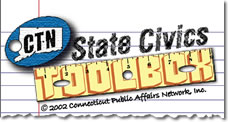|
|
CT-N Legislative Session Click Here for the Word Document version of this page. |
Video Session: Use an appropriate taped CT-N session of the Connecticut House of Representatives or Senate discussing a bill with clearly defined party arguments. Check our
Hot Topics page for ideas.
Content: A bill on the floor of the General Assembly.
Additional Materials Needed:
- Maps of the state with Assembly districts; political, topographical …
- Statistical data of region www.census.gov
- Demographics www.census.gov/population
- Voting habits (use local registrar of voters office)
- Educational levels (state and federal census bureau)
- Economic base (state and federal census bureau)
- Newest census report http://quickfacts.census.gov
- Political affiliations CT-N website
- Past voting records CT Secretary Of State
- Chart paper or graphing software (Microsoft Excel)
- TV/VCR to view video of session in General Assembly
- Internet access to data
Class Time: Five (5) class periods.
Objectives: To help students understand the role of regionalism in a political arena. Emphasis will be placed on geography, demographics and the cooperation among district representatives in developing political strategies and decision making. Students will also draw conclusions on the passage or death of a bill based on regional characteristics.
Activity:
- Day 1: In preparation, the students will watch the selected clip(s) of a CT-N debate.
Remember to stop the videotape before the vote!- Students can be divided into groups to examine a specific legislator and the district they represent.
- Using prior knowledge of the state geographic composition, students will analyze the assigned district - How is this district going to vote? Why? Record the various opinions in the group.
- Or, students will read the local daily newspaper for the purpose of locating an issue that is before the General Assembly. Articles may be selected and provided by the classroom teacher. Click here for Newspaper Links.
- Students will share/examine the various issues currently debated by the state General Assembly.
- Students will choose ONE topic to investigate
- The class will be divided into four (4) specified Assembly districts -- # 92-97 (New Haven); # 8 (Vernon, Coventry, Columbia); # 98 (Branford, Guilford); # 67 (New Milford)
- Using prior knowledge of the state geographic composition, students will analyze the assigned district - How is this district going to vote? Why? Record the various opinions in the group.
- Day 2 & 3: Members of each group will gather detailed information about their district
- Name of the representative(s); a comprehensive background check of the political party/parties represented; length in the house; previous positions/opinions on the issue or similar issues i.e. voting record;
- Methods used by the representatives to pole their constituency
- Demographics information – vital statistics of the district
- Importance of the issue to the district
- Day 4: Each member of the group will share and analyze the gathered information
- Is the district opposed to the bill? Why/how the district reached this consensus?
- Is the representative sensitive to the opinions in the district? – show proof
- Create a graph to illustrate the group’s findings (to be shared with the other groups on day 5).
- Day 5: Each group will share their findings and draw conclusions on the future of the proposed bill.
- What are the differences/ similarities among the districts? Document the findings i.e. how are the districts similar/different in geography, economy, historical background and local needs.
- Were some of the differences/similarities in the districts changed due to cooperative negotiations among districts (for the common good)? Present documentation.
- If the districts represented controlled the Assembly, would the bill become law? Why?
- Play the CT-N videotape and watch the vote. Discuss the results based on what the class predicted.
Assessment:
The oral presentations and researched information can be assessed using a CAPT rubric.
SOURCES:
- CT-N Archives
- CT State Library
- CT Historical Society
- Legislative web sites
- Local libraries (district)
- Local newspapers
- Census Databases
- Public Radio Broadcasting
If you have any comments or suggestions about this activity or would like to submit your own activity, please contact us and share your ideas.
